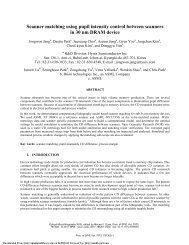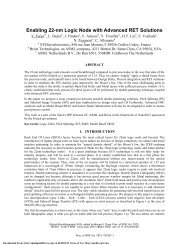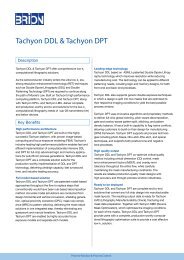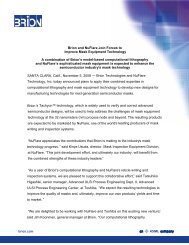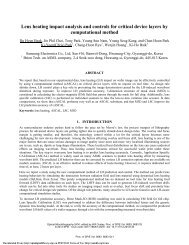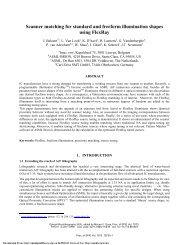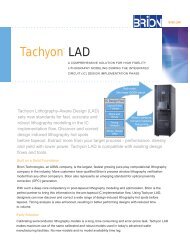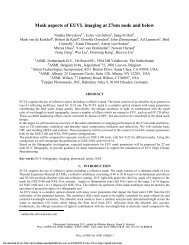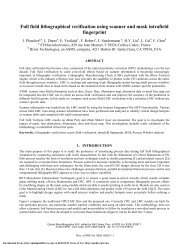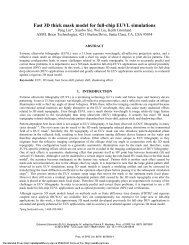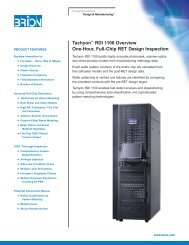Holistic lithography for EUV - Brion Technologies, Inc.
Holistic lithography for EUV - Brion Technologies, Inc.
Holistic lithography for EUV - Brion Technologies, Inc.
- No tags were found...
Create successful ePaper yourself
Turn your PDF publications into a flip-book with our unique Google optimized e-Paper software.
the full process in the <strong>for</strong>mer case, and multiple litho-clusters in the latter. This is of special importance during highvolume<br />
manufacturing (HVM). YieldStar is unique in that it is capable of measuring overlay, CD uni<strong>for</strong>mity, resist<br />
thickness as well as focus (focus being under development in <strong>EUV</strong>) and it can interface with scanners through a product<br />
called BaseLiner to further stabilize the scanners. A schematic overview of the holistic <strong>lithography</strong> concept is shown in<br />
Figure 1. In the near future we will see further enhanced automation and data transfer between the three major<br />
components that <strong>for</strong>m <strong>EUV</strong> holistic <strong>lithography</strong>.<br />
In this paper we will describe the components of this total <strong>lithography</strong> approach and we will give examples how it was<br />
used to verify wafer results and compare them with predictions.<br />
Figure 1: Schematic explaining holistic <strong>lithography</strong> <strong>for</strong> <strong>EUV</strong>: mutual interaction and integration of 1) NXE wafer exposure <strong>for</strong><br />
production, with 2) computational <strong>lithography</strong> <strong>for</strong> prediction and (mask) correction, and 3) dedicated metrology <strong>for</strong> verification and<br />
control during high-volume manufacturing (HVM).<br />
2. NXE SCANNER UPDATE<br />
2.1 Scanner update<br />
The NXE:3100 systems are ASML’s first generation <strong>EUV</strong> scanners <strong>for</strong> the semiconductor factories; they transfer the<br />
learning of the two alpha-demo tools at IMEC and Albany to the industry. The NXE:3100 has been manufactured in a<br />
limited edition. The year 2011 truly marks the introduction of <strong>EUV</strong> scanners to the industry: six NXE:3100’s have been<br />
transferred to customers. While writing this paper, three of them were exposing wafers, two of them were under<br />
installation and one was in final shipment phase.<br />
The default illumination mode of the NXE:3100 has a numerical aperture (NA) of 0.25 and conventional illumination at<br />
σ _outer = 0.8. A selection of popular off-axis illumination (OAI) modes is possible as well albeit at the cost of a reduction<br />
of precious <strong>EUV</strong> light intensity. The NXE:3100 is intended to enable the 27-nm half-pitch node. An early per<strong>for</strong>mance<br />
validation has been reported by C. Wagner et al. 2<br />
The NXE plat<strong>for</strong>m is designed to support multiple technology nodes. The second generation scanner from this plat<strong>for</strong>m,<br />
the NXE:3300, will have an NA=0.33, a maximum σ _outer = 0.9, a selected set of loss-less OAI modes, and it intends to<br />
serve the industry down to 16-nm resolution. The NXE:3300 will also have again further-reduced flare values, higher<br />
source power, as well as a significantly lower footprint, which are all important factors <strong>for</strong> volume manufacturing.<br />
Proc. of SPIE Vol. 8166 81660Z-2<br />
Downloaded From: http://proceedings.spiedigitallibrary.org/ on 04/08/2013 Terms of Use: http://spiedl.org/terms



